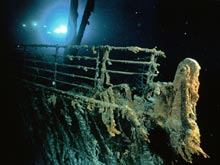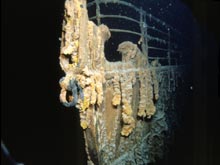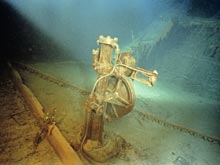R.M.S. Titanic 2004 Expedition
May 27 – June 12, 2004
Jeremy B. Weirich
Lieutenant Junior Grade, NOAA Corps
Marine Archaeologist
NOAA Office of Ocean Exploration
Nearly 20 years after first finding the sunken remains of the RMS Titanic, marine explorer Robert Ballard returned in June 2004 to help the National Oceanic and Atmospheric Administration (NOAA) study the ship's rapid deterioration.
A professor of oceanography at the University of Rhode Island (URI) ![]()
![]() and director of its Institute for Archaeological Oceanography, Dr. Ballard and his team of scientists from NOAA and other institutions spent 11 days at the site, mapping the ship and conducting scientific analyses of its deterioration. The team worked aboard the NOAA Research Vessel Ronald H. Brown from May 30 through June 9, and used remotely operated vehicles (ROVs) to conduct a sophisticated documentation of the state of Titanic that was not possible in the 1980s. This “Look, don’t touch” mission utilized high-definition video and stereoscopic still images to provide an updated assessment of the wreck site.
and director of its Institute for Archaeological Oceanography, Dr. Ballard and his team of scientists from NOAA and other institutions spent 11 days at the site, mapping the ship and conducting scientific analyses of its deterioration. The team worked aboard the NOAA Research Vessel Ronald H. Brown from May 30 through June 9, and used remotely operated vehicles (ROVs) to conduct a sophisticated documentation of the state of Titanic that was not possible in the 1980s. This “Look, don’t touch” mission utilized high-definition video and stereoscopic still images to provide an updated assessment of the wreck site.
The science team included Dr. Dwight Coleman of URI and the Mystic Aquarium & Institute for Exploration (MAIFE) ![]()
![]() , who was the expedition's research chief. As the marine archaeologist with NOAA's Office of Ocean Exploration, I oversaw the expedition's marine archaeology component. In addition to mapping the Titanic, expedition goals included the microbial research of scientist Roy Cullimore, who studied the natural deterioration of the ship's hull. Tiny microbes that feed on iron and create icicle-shaped formations called rusticles are responsible for this deterioration. While rusticles have been observed for many years, little is known about them.
, who was the expedition's research chief. As the marine archaeologist with NOAA's Office of Ocean Exploration, I oversaw the expedition's marine archaeology component. In addition to mapping the Titanic, expedition goals included the microbial research of scientist Roy Cullimore, who studied the natural deterioration of the ship's hull. Tiny microbes that feed on iron and create icicle-shaped formations called rusticles are responsible for this deterioration. While rusticles have been observed for many years, little is known about them.
As the nation's ocean agency, NOAA has a vested interest in the scientific and cultural aspects of the Titanic, and in its appropriate treatment and preservation. NOAA's focus is to build a baseline of scientific information from which we can measure the shipwreck's processes and deterioration, and then apply the knowledge we gain to other deep-water shipwrecks and submerged cultural resources.
The Guidelines for Research, Exploration and Salvage of RMS Titanic
(9 pages, 108k) were issued under the authority of the RMS Titanic Maritime Act of 1986.
On Monday, June 7, 2004, at 9 p.m. ET/PT, the National Geographic Channel gave audiences
unprecedented access to the ongoing expedition by broadcasting a one-hour special,
"Return to Titanic ![]() ,"
," ![]() which originated from the NOAA R/V Ronald H. Brown and included a live underwater telecast from the Titanic.
which originated from the NOAA R/V Ronald H. Brown and included a live underwater telecast from the Titanic.
Simultaneous with the expedition, MAIFE enabled thousands of children to experience the Titanic mission as it occurred. From June 4 through 9, four shows a day
were transmitted live from the expedition via satellite and Internet2 to participating sites. The
JASON Foundation ![]()
![]() for Education has create a new middle-school math curriculum called "JASON Math Adventure: Geometry and Return to Titanic," which follows the work of researchers on the expedition. Students will learn how geometry concepts are used to position the Ronald H. Brown at the Titanic wreck and the ROV Hercules on the Titanic's bow.
for Education has create a new middle-school math curriculum called "JASON Math Adventure: Geometry and Return to Titanic," which follows the work of researchers on the expedition. Students will learn how geometry concepts are used to position the Ronald H. Brown at the Titanic wreck and the ROV Hercules on the Titanic's bow.
Technology partners on the expedition included EDS of Texas, which wired the mission, and VBrick Systems of Connecticut, which enabled the mission feed to be broadcast nationwide.
Related Links
R.M.S. Titanic Expedition 2003
NOAA Ocean Explorer Titanic Gallery
Sign up for the Ocean Explorer E-mail Update List.












